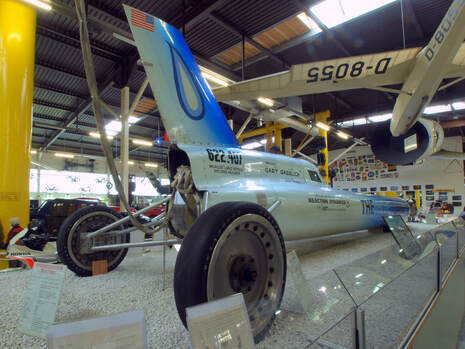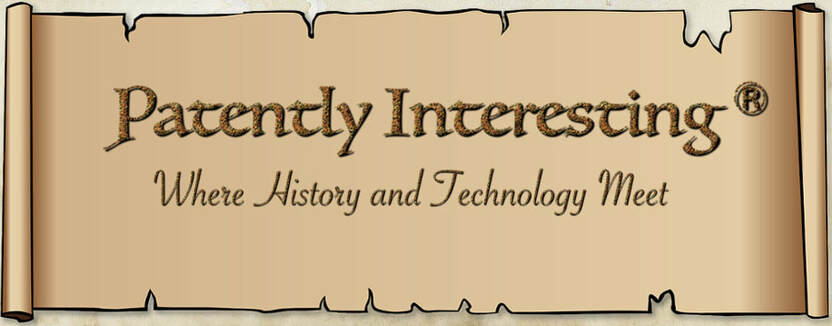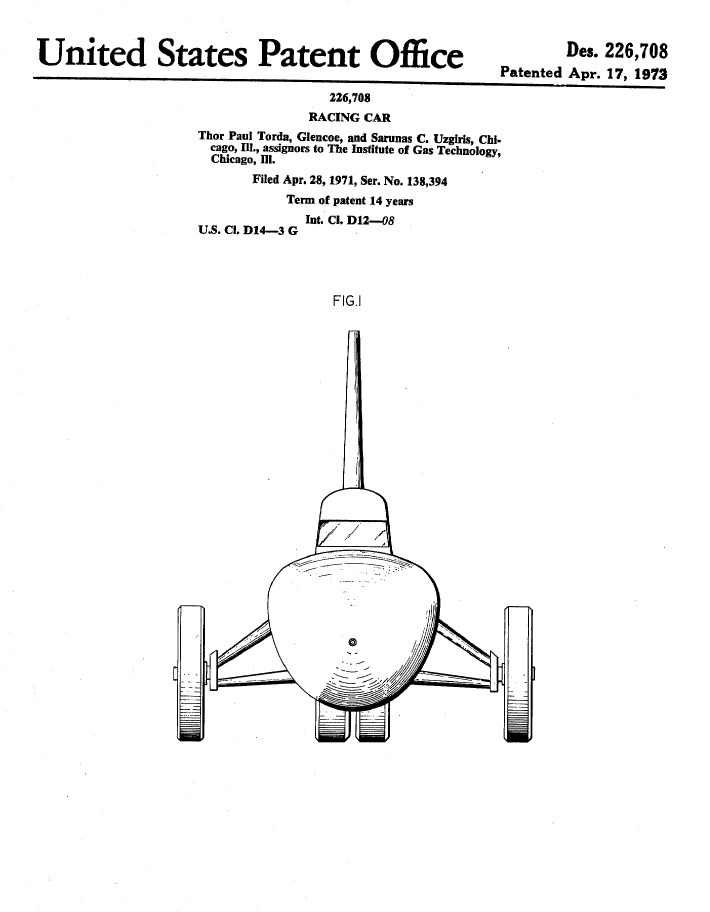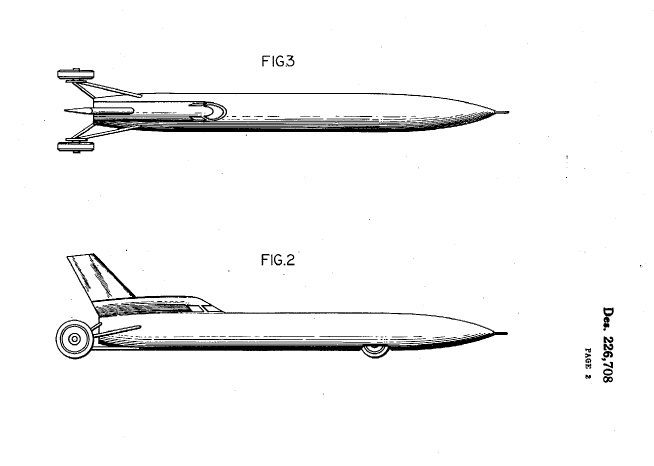 The Blue Flame
The Blue Flame
On April 17, 1973, U.S. Design Patent No.: 226,708 issued to Thor Paul Torda and Sarunas C. Uzgiris for a "Racing Car". The patent was for the "Blue Flame", which was a rocket-powered car that broke the world land speed record on October 23, 1970 at Bonneville Salt Flats, with a speed of 630.478 mph, over a distance of 1 km. The "Blue Flame" was driven by Gary Gabelich and was designed and built by Reaction Dynamics, Inc., with the assistance from the faculty and students of the Illinois Institute of Technology ("IIT"). The inventors of the '708 patent, Dr. Torda and Dr. Uzgiris, were professors at IIT.
The idea for a rocket-powered car originated with Dick Keller and Ray Dausman in 1964 and later included Pete Farnsworth. Keller and Dausman worked at the IIT Research Institute and often had lunch together, where they shared their passion for racing. Keller had been an amateur drag racer, but went into retirement upon getting married. During their lunch conversations, Keller and Dausman hit upon the idea of a rocket-powered dragster. After succesfully building and testing a small prototype rocket engine, the pair enlisted the help of Pete Farnsworth to build the rocket-powered dragster envisioned by Keller and Dausman. Farnsworth was a friend of Keller's and was a part-time builder and racer of drag racing cars. Together, Keller, Dausman and Farnsworth formed Reaction Dynamics to build the dragster, which was called the X-1.
The Reaction Dynamics team finished the X-1 dragster in April of 1967. The X-1 was a small car, but its engine could deliver 2,500 pounds of thrust, using hydrogen peroxide as a propellant. Later in 1967, the X-1 started competing against turbojet-powered dragsters, beating each one it came up against. This success emboldened the team to consider building a more powerful engine for a car that could capture the land speed record. This engine would use liquefied natural gas (LNG) and hydrogen peroxide. The idea for the Blue Flame had been born.
Keller approached Dr. Henry R. Linden of the Institute of Gas Technology (IGT) with the idea for the Blue Flame and its quest for the land speed record. Dr. Linden supported the idea and was able to secure funding for the Blue Flame from the natural gas industry. Since the IGT was affiliated with IIT, Dr. Linden was also able to secure the help of Dr. Torda, Dr. Uzgiris and a group of IIT students, including Thomas A. Morel. Drs. Torda and Uzgiris and Morel worked on the aerodynamic aspects of the Blue Flame, while other IIT students and faculty members worked on the structure, engine, steering and brakes for the Blue Flame.
Ostensibly, it was Morel who determined that the body of the Blue Flame should have its cross-section shaped like a rounded triangle, with the apex oriented toward the ground to minimize the effect of shockwaves formed underneath. In addition, Morel determined that the body should be inclined a couple of degrees toward the nose to keep the nose down, without putting too much stress on the tires. Morel's contributions can be seen in the '708 design patent.
It is interesting that a design patent was obtained for the Blue Flame since aerodynamic considerations clearly dictated its design, which is in contradistinction to the requirement that a design patent be directed toward ornamental features and not functional features of an object.
The idea for a rocket-powered car originated with Dick Keller and Ray Dausman in 1964 and later included Pete Farnsworth. Keller and Dausman worked at the IIT Research Institute and often had lunch together, where they shared their passion for racing. Keller had been an amateur drag racer, but went into retirement upon getting married. During their lunch conversations, Keller and Dausman hit upon the idea of a rocket-powered dragster. After succesfully building and testing a small prototype rocket engine, the pair enlisted the help of Pete Farnsworth to build the rocket-powered dragster envisioned by Keller and Dausman. Farnsworth was a friend of Keller's and was a part-time builder and racer of drag racing cars. Together, Keller, Dausman and Farnsworth formed Reaction Dynamics to build the dragster, which was called the X-1.
The Reaction Dynamics team finished the X-1 dragster in April of 1967. The X-1 was a small car, but its engine could deliver 2,500 pounds of thrust, using hydrogen peroxide as a propellant. Later in 1967, the X-1 started competing against turbojet-powered dragsters, beating each one it came up against. This success emboldened the team to consider building a more powerful engine for a car that could capture the land speed record. This engine would use liquefied natural gas (LNG) and hydrogen peroxide. The idea for the Blue Flame had been born.
Keller approached Dr. Henry R. Linden of the Institute of Gas Technology (IGT) with the idea for the Blue Flame and its quest for the land speed record. Dr. Linden supported the idea and was able to secure funding for the Blue Flame from the natural gas industry. Since the IGT was affiliated with IIT, Dr. Linden was also able to secure the help of Dr. Torda, Dr. Uzgiris and a group of IIT students, including Thomas A. Morel. Drs. Torda and Uzgiris and Morel worked on the aerodynamic aspects of the Blue Flame, while other IIT students and faculty members worked on the structure, engine, steering and brakes for the Blue Flame.
Ostensibly, it was Morel who determined that the body of the Blue Flame should have its cross-section shaped like a rounded triangle, with the apex oriented toward the ground to minimize the effect of shockwaves formed underneath. In addition, Morel determined that the body should be inclined a couple of degrees toward the nose to keep the nose down, without putting too much stress on the tires. Morel's contributions can be seen in the '708 design patent.
It is interesting that a design patent was obtained for the Blue Flame since aerodynamic considerations clearly dictated its design, which is in contradistinction to the requirement that a design patent be directed toward ornamental features and not functional features of an object.



